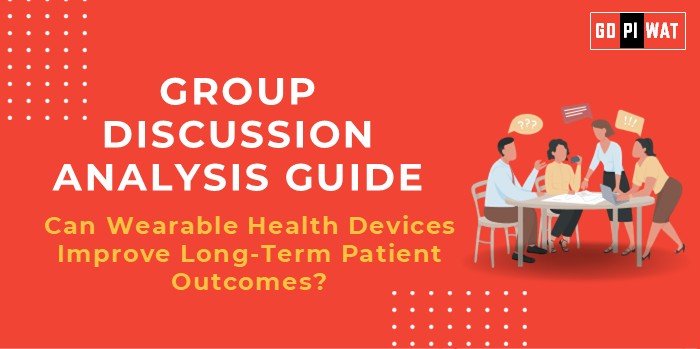📋 Group Discussion Analysis Guide: Can Wearable Health Devices Improve Long-Term Patient Outcomes?
🌐 Introduction to the Topic
Opening Context: Wearable health devices, like smartwatches and fitness trackers, are transforming the healthcare landscape by offering real-time health monitoring. Their growing adoption highlights the interplay between technology and proactive healthcare.
Topic Background: The integration of wearable devices into healthcare started with step counters and has evolved into tools capable of monitoring heart rate, sleep quality, and even detecting arrhythmias. Recent advancements include continuous glucose monitors and stress tracking, enabling better chronic disease management.
📊 Quick Facts and Key Statistics
- Market Growth: The global wearable health device market is expected to reach $195 billion by 2027, growing at a CAGR of 25% (Fortune Business Insights, 2023).
- Adoption Rate: Approximately 30% of Americans use a wearable health device, with usage growing globally (Statista, 2023).
- Chronic Disease Impact: Wearables have reduced hospitalizations for heart failure patients by 38% in pilot studies (JAMA, 2023).
- Insurance Integration: 25% of U.S. health insurers offer discounts for wearable device users due to their role in preventive care.
🔗 Stakeholders and Their Roles
- Patients: Use wearables for real-time health insights, enabling lifestyle changes and adherence to treatment plans.
- Healthcare Providers: Leverage device data for personalized care plans and remote monitoring.
- Tech Companies: Innovate wearable technology and data analytics for improved health outcomes.
- Insurance Companies: Encourage wearable adoption to reduce claims by promoting preventive care.
- Regulatory Bodies: Ensure data privacy and establish standards for device efficacy.
🏆 Achievements and Challenges
- Achievements:
- Remote Monitoring Success: Reduced outpatient visits by 20% in trials with hypertensive patients.
- Improved Adherence: Diabetics using continuous glucose monitors report 75% compliance with treatment plans.
- Early Detection: Detecting arrhythmias like AFib has saved lives through timely interventions.
- Lifestyle Changes: Increased physical activity among users, leading to a 15% reduction in obesity rates.
- Challenges:
- Data Privacy Concerns: Issues with data sharing and protection discourage adoption.
- Device Accuracy: Variability in readings limits clinical reliability.
- Access Disparity: High costs and limited internet access hinder widespread use in low-income groups.
Global Comparisons:
- U.S.: Extensive integration of wearables with insurance incentives.
- Japan: Advanced applications for aging populations.
- India: Limited penetration due to cost barriers, though initiatives like affordable wearables show promise.
Case Studies:
- Apple Watch’s ECG feature: Proven to detect AFib in clinical trials, enhancing preventive care.
- Fitbit-Health Insurance Collaboration: Demonstrated reduced healthcare costs and improved user outcomes.
⚖️ Structured Arguments for Discussion
- Supporting Stance: “Wearables empower patients to take charge of their health, reducing hospitalizations and improving quality of life.”
- Opposing Stance: “Concerns around data privacy, cost, and device accuracy must be addressed before wearables can revolutionize healthcare.”
- Balanced Perspective: “While wearable devices have shown promise, their effectiveness hinges on addressing access and reliability challenges.”
🛠️ Effective Discussion Approaches
- Opening Approaches:
- Data-Driven Start: “The wearable health device market is growing at 25% annually, yet questions about their long-term impact remain.”
- Case Study Example: “Devices like Apple Watch have saved lives through early arrhythmia detection.”
- Provocative Statement: “Can technology alone solve the global healthcare crisis?”
- Counter-Argument Handling:
- Acknowledge privacy concerns but highlight regulations like GDPR.
- Emphasize ongoing improvements in device accuracy with AI.
- Stress affordability initiatives for broader access.
📊 SWOT Analysis
- Strengths: Real-time monitoring, preventive care, lifestyle improvements.
- Weaknesses: Data security, access disparity.
- Opportunities: AI-driven diagnostics, insurance partnerships.
- Threats: Regulatory hurdles, user mistrust.
📈 Connecting with B-School Applications
- Real-World Applications: Integration of wearable technology into healthcare startups, business models in insurance-tech partnerships.
- Sample Interview Questions:
- “How can wearables bridge the gap between technology and traditional healthcare?”
- “What role can AI play in enhancing wearable device efficacy?”
- Insights for B-School Students:
- Explore case studies linking technology with public health.
- Investigate market entry strategies for health-tech startups in emerging economies.


